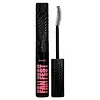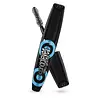What's inside
What's inside
 Key Ingredients
Key Ingredients

 Benefits
Benefits

 Concerns
Concerns

 Ingredients Side-by-side
Ingredients Side-by-side

Water
Skin ConditioningCera Alba
EmollientPolyacrylate-21
Hydrogenated Olive Oil Stearyl Esters
Emulsion StabilisingVp/Eicosene Copolymer
Polybutene
Oryza Sativa Bran Wax
Skin ConditioningStearyl Alcohol
EmollientCopernicia Cerifera Wax
Palmitic Acid
EmollientStearic Acid
CleansingAcacia Senegal Gum
MaskingButylene Glycol
HumectantAminomethyl Propanediol
Buffering1,2-Hexanediol
Skin ConditioningPanthenol
Skin ConditioningCaprylyl Glycol
EmollientChlorphenesin
AntimicrobialHydroxyacetophenone
AntioxidantTrideceth-6 Phosphate
EmulsifyingVaccinium Macrocarpon Seed Oil
Skin ConditioningSodium Dilauramidoglutamide Lysine
HumectantTocopheryl Acetate
AntioxidantDipropylene Glycol
HumectantGlyceryl Caprylate
EmollientHelianthus Annuus Seed Oil
EmollientRosmarinus Officinalis Leaf Extract
AntimicrobialCI 77499
Cosmetic ColorantWater, Cera Alba, Polyacrylate-21, Hydrogenated Olive Oil Stearyl Esters, Vp/Eicosene Copolymer, Polybutene, Oryza Sativa Bran Wax, Stearyl Alcohol, Copernicia Cerifera Wax, Palmitic Acid, Stearic Acid, Acacia Senegal Gum, Butylene Glycol, Aminomethyl Propanediol, 1,2-Hexanediol, Panthenol, Caprylyl Glycol, Chlorphenesin, Hydroxyacetophenone, Trideceth-6 Phosphate, Vaccinium Macrocarpon Seed Oil, Sodium Dilauramidoglutamide Lysine, Tocopheryl Acetate, Dipropylene Glycol, Glyceryl Caprylate, Helianthus Annuus Seed Oil, Rosmarinus Officinalis Leaf Extract, CI 77499
Water
Skin ConditioningParaffin
PerfumingGlyceryl Stearate
EmollientCopernicia Cerifera Cera
EmollientPvp
Emulsion StabilisingCera Alba
EmollientPropylene Glycol
HumectantTribehenin
EmollientPolysorbate 20
EmulsifyingStearic Acid
CleansingAmmonium Acrylates Copolymer
Panthenol
Skin ConditioningCaprylyl Glycol
EmollientHydroxyethylcellulose
Emulsion StabilisingTocopheryl Acetate
AntioxidantSodium Hydroxide
BufferingTalc
AbrasiveAcrylates/Carbamate Copolymer
Skin ConditioningAscorbyl Glucoside
AntioxidantGossypium Herbaceum Powder
AbsorbentSerica Powder
Skin ConditioningRetinyl Palmitate
Skin ConditioningHydrogenated Vegetable Oil
EmollientGlycerin
HumectantCollagen
MoisturisingHydrogenated Olive Oil
Skin ConditioningOlea Europaea Fruit Oil
MaskingHydrolyzed Keratin
HumectantPrunus Armeniaca Kernel Oil
MaskingSodium Sulfate
Ceramide Ns
Skin ConditioningOlea Europaea Oil Unsaponifiables
Skin ConditioningPotassium Sorbate
PreservativePhenoxyethanol
PreservativeBambusa Arundinacea Leaf Extract
Skin ConditioningSodium Benzoate
MaskingTocopherol
AntioxidantCI 75470
Cosmetic ColorantCI 77289
Cosmetic ColorantCI 77288
Cosmetic ColorantCI 77510
Cosmetic ColorantIron Oxides
Mica
Cosmetic ColorantCI 77891
Cosmetic ColorantCI 77007
Cosmetic ColorantWater, Paraffin, Glyceryl Stearate, Copernicia Cerifera Cera, Pvp, Cera Alba, Propylene Glycol, Tribehenin, Polysorbate 20, Stearic Acid, Ammonium Acrylates Copolymer, Panthenol, Caprylyl Glycol, Hydroxyethylcellulose, Tocopheryl Acetate, Sodium Hydroxide, Talc, Acrylates/Carbamate Copolymer, Ascorbyl Glucoside, Gossypium Herbaceum Powder, Serica Powder, Retinyl Palmitate, Hydrogenated Vegetable Oil, Glycerin, Collagen, Hydrogenated Olive Oil, Olea Europaea Fruit Oil, Hydrolyzed Keratin, Prunus Armeniaca Kernel Oil, Sodium Sulfate, Ceramide Ns, Olea Europaea Oil Unsaponifiables, Potassium Sorbate, Phenoxyethanol, Bambusa Arundinacea Leaf Extract, Sodium Benzoate, Tocopherol, CI 75470, CI 77289, CI 77288, CI 77510, Iron Oxides, Mica, CI 77891, CI 77007
 Reviews
Reviews

Ingredients Explained
These ingredients are found in both products.
Ingredients higher up in an ingredient list are typically present in a larger amount.
Caprylyl Glycol is a humectant and emollient, meaning it attracts and preserves moisture.
It is a common ingredient in many products, especially those designed to hydrate skin. The primary benefits are retaining moisture, skin softening, and promoting a healthy skin barrier.
Though Caprylyl Glycol is an alcohol derived from fatty acids, it is not the kind that can dry out skin.
This ingredient is also used as a preservative to extend the life of products. It has slight antimicrobial properties.
Learn more about Caprylyl GlycolCera alba is beeswax, or the wax used by bees to make honeycombs. It is a texture-enhancer and emollient. A study from 2003 found beeswax to be a stronger emollient than ingredients such as petroleum jelly.
As an emollient, beeswax helps hydrate the skin by creating a barrier on top. This barrier traps moisture in.
Emulsifiers help prevent ingredients from separating. This helps create consistent texture.
The structure of beeswax is mainly long-chain alcohols and the esters of fatty acids.
There are three types of beeswax: yellow, white, and absolute. Yellow is pure beeswax taken from the honeycomb. White beeswax is created by filtering or bleaching yellow beeswax. Absolute beeswax is created by treating beeswax with alcohol. Beeswax used in cosmetics are purified.
Beeswax has been used throughout history and even in prehistoric times. Some common uses for beeswax still used today are making candles, as a waterproofing agent, and polish for leather.
Learn more about Cera AlbaPanthenol is a common ingredient that helps hydrate and soothe the skin. It is found naturally in our skin and hair.
There are two forms of panthenol: D and L.
D-panthenol is also known as dexpanthenol. Most cosmetics use dexpanthenol or a mixture of D and L-panthenol.
Panthenol is famous due to its ability to go deeper into the skin's layers. Using this ingredient has numerous pros (and no cons):
Like hyaluronic acid, panthenol is a humectant. Humectants are able to bind and hold large amounts of water to keep skin hydrated.
This ingredient works well for wound healing. It works by increasing tissue in the wound and helps close open wounds.
Once oxidized, panthenol converts to pantothenic acid. Panthothenic acid is found in all living cells.
This ingredient is also referred to as pro-vitamin B5.
Learn more about PanthenolStearic Acid is a fatty acid. It is an emollient, emulsifier, and texture enhancer.
As an emollient, stearic acid helps soften skin. It aids the skin's protective barrier by preventing water loss. It also provides a gentle cleansing effect without stripping away natural oils.
Stearic acid may also be used to enhance the texture of products. It can add volume and stabilize ingredients such as water and oil. This can help water and oil ingredients from separating.
Sources of stearic acid include animal or vegetable fats/oils such as coconut or shea. It can be naturally found in butter, cocoa butter, shea butter, vegetable fats, and animal tallow.
This ingredient may not be Malassezia folliculitis, or fungal-acne safe.
Learn more about Stearic AcidTocopheryl Acetate is AKA Vitamin E. It is an antioxidant and protects your skin from free radicals. Free radicals damage the skin by breaking down collagen.
One study found using Tocopheryl Acetate with Vitamin C decreased the number of sunburned cells.
Tocopheryl Acetate is commonly found in both skincare and dietary supplements.
Learn more about Tocopheryl AcetateWater. It's the most common cosmetic ingredient of all. You'll usually see it at the top of ingredient lists, meaning that it makes up the largest part of the product.
So why is it so popular? Water most often acts as a solvent - this means that it helps dissolve other ingredients into the formulation.
You'll also recognize water as that liquid we all need to stay alive. If you see this, drink a glass of water. Stay hydrated!
Learn more about Water